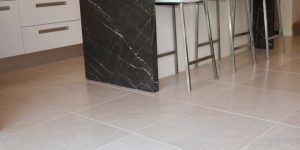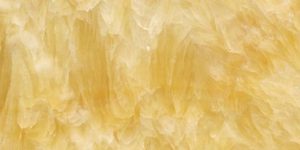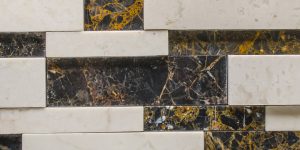What is in these names is not always clear. Basalt is actually mineralogically a fine-grained gabbro, but is seldom defined as such. The buyer looking for a gabbro is discouraged when the seller is actually offering unwittingly basalt and the buyer moves on to the next supplier. In the same vain Norite is not mentioned in the Standard but is a gabbro with more orthopyroxene than clinopyroxene. This mineralogical surplus may sound natural to the geologist, but makes correct use of scientific names difficult in commercial practice.
The information (in italics) in the Standard is that the mafic iron containing minerals gives the stone its black colour. More specifically the magnetite needles are supplying the deep black in Belfast Black (see below), help the stone consultant in evaluation -all the boss wants is blacker than black.
Belfast Black Granite
Until recently, the ASTM discussion was considered informative rather than of normative interest. However with the ‘enforcement’ of the CEN stone standards with mandatory petrographic description requirements as starting point, these have to be taken seriously. They affect specification, which govern price and quality, both serious items in the industry, besides legal coverage for the buyer and seller.
This is especially true for plain black granites where the grain sizes of the matrix are to be uniform throughout the deposit, causing more often than not the quarry recovery rates (the percentage of marketable material obtained from any volume of material excavated) of less than 5% of the prime material, to the regret of the quarrier. Ideally the grain size of the major constituent,plagioclase, for a fine-grained material should average less than 0.5 mm.
At the end of the slab fabrication, the colour may range from pitch-black (whatever that implies) to darkish grey.
The polished or honed stone may have specks, some causing a glint like in Galaxy Black granite, tiny white spots in any size, shape, colour or shade; may have a brownish, bluish, greenish hue and may be described as deep, dark, medium, light or greyish.
Galaxy Black granite
Often a gradual transition from the blacks into the greys takes place at the quarry, calling for selective quarrying to reduce colour variation and increasing extraction costs. Samples for inspection are to be polished on one side and honed on the obverse, even if honed is required, as the true and more lasting colours are brought up by polishing, besides showing any defaults.
With the advent of denomination criteria in the approved CEN Standards the discussion of scientific versus commercial denomination has become hopefully redundant. Just for old times’ sake let us look over some denominations of “Black Granites” (or dark greys with an essentially with black matrix). Some of the original names are still being used to indicate varieties. The names in Italics may have become the main appellation, especially by old-timers in the industry.
The classification into categories depend on the petrographical examination (CEN 12407) Standard of random samplings from quarry faces and locations, that may have been changed with the years, and therefore may have turned arbitrary. The categories may even be different for stone within the same working. Anyway, the list is indicative, not exhaustive. Application of CEN 12407 may in good time rectify the situation and a name will be the proper name.
Pros of Black Granite
Variations of black granite are all very stylish and can fit in well with virtually any color of cabinets and walls.
One of the major advantages that black granite will offer you, and any type of granite for that matter, is stain resistance. If the stone is properly sealed, you should have no problems with staining. This can be especially helpful if you utilize the material for your kitchen countertops.
Cons of Black Granite
As with any kind of natural stone, black granite will come at a cost. However, these prices are not as prohibitive as some other stones. Black granite that is rarer will cost more money. Additional factors such as how much of the material you need will also determine the price.
Some types of black granite are more prone to showing fingerprints and dust than others. All you need to do is clean your black granite and this will be no issue.
Popular Styles of Black Granite
Black granite comes in a lovely array of styles that will be a major improvement regardless of where you use the stone in your house. This guide will give you some information about many of the popular types of black granite. 30 popular types of black granite include:
- Black Galaxy
- Cosmic Black
- Altair
- Black Antique
- Ubatuba
- African Galaxy
- Orion
- Negresco
- Absolute Black
- Black Pearl
- Black Fusion
- Matrix
- Angola Silver
- Black Impala
- Black Mist
- San Gabriel
- Marinace
- Viking Black
- Atlantic Black
- Via Lactea
- Titanium Black
- Sedna
- Black Sun
- Jet Mist
- Cheyenne
- Azteca
- Black Thulu
- Kosmus
- Porto Rosa
- Magma Black









